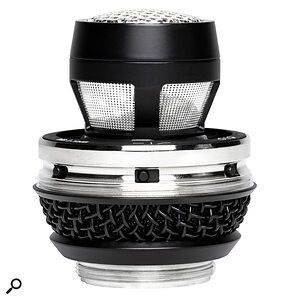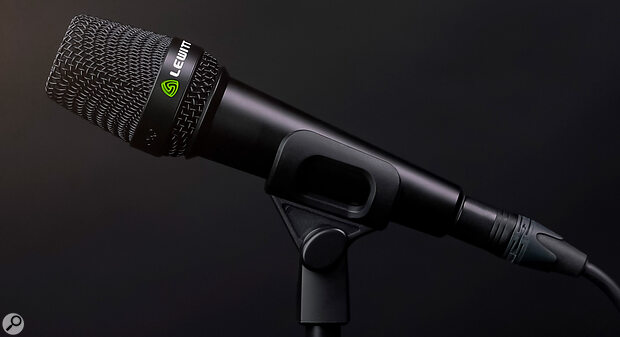This classy vocal mic brings studio sound quality to the stage.
Austrian company Lewitt Audio have a deservedly strong reputation for building high‑quality microphones. In the new MTP W950, they’ve taken a one‑inch, dual‑diaphragm capacitor capsule of the type you’d usually find in a studio mic, and placed it in a housing designed to work in a live‑sound environment. This capsule has switchable cardioid or supercardioid patterns, and features exceptionally good rear rejection. In cardioid mode the maximum rejection is at 180 degrees off‑axis, while in supercardioid mode it is at 120 degrees. The basket features built‑in dual‑layer pop/wind filtering, and the capsule has a robust suspension system to minimise handling noise. The basket also affords protection against moisture from the singer’s breath, and has been designed to help preserve sonic performance if the artist cups their hand around the mic.
 The W950 uses a dual‑diaphragm capacitor capsule, with a built‑in suspension for minimising handling noise.
The W950 uses a dual‑diaphragm capacitor capsule, with a built‑in suspension for minimising handling noise.
A switchable 12dB pad accommodates loud sound sources, while another switch brings in a 120Hz low‑cut filter. The mic top has to be removed to access the filter, pad and pattern switches, which prevents inadvertent setting changes when in use. It is also possible to use the capsule as part of a wireless system with a suitable transmitter body. Compatible systems are listed on the Lewitt website. The mic comes with a semi‑rigid transport case, microphone clip and windscreen. Overall, the mic measures 51 x 183mm and it weighs 379g.
As you’d expect from Lewitt, the mic has a reassuring technical specification. Sensitivity is 8.1mV/Pa, self‑noise is 21dBA, signal‑to‑noise ratio is 73dBA and its dynamic range is 119dBA. Maximum SPL handling at 0.5% THD is a very loud 140dB. A standard phantom power source of 48V (±4V) is required.
The frequency response graph for cardioid mode shows a gentle roll‑off below 200Hz to counter the proximity effect, and a couple of humps up in the presence region with a gentle lift at around 3.5kHz and a stronger hump up around 9kHz. In supercardioid mode the strongest hump is around 4kHz, but there’s nothing excessive in either mode, and the frequency response extends to 20kHz. However, Lewitt weren’t satisfied with just achieving a good paper specification: they also sent out pre‑release models with top‑tier touring acts to be sure the mic performed under real‑world conditions.
The MTP W950 delivers the type of performance that I’d expect from a good‑quality studio capacitor microphone...
Centre Stage
Tested at a distance of around 150mm and with the filter off, the sound came over as natural and full‑bodied, with a reasonable resistance to popping. Indeed, the W950 delivers the type of performance that I’d expect from a good‑quality studio capacitor microphone, so if you perform live and also have a home studio, it will serve you well in both scenarios.
Turning on the low‑cut filter does bring about a noticeable reduction in the low end — but if you move closer than around 75mm away, as you probably would in a live performance, proximity effect builds up to counter this, so you still get a well‑balanced tonality. The mids and highs sound very natural, without the nasal character that you sometimes get with live vocal mics.
Despite the slight differences in the frequency responses of the two patterns, I didn’t notice any significant tonal change when switching to supercardioid mode, and the rejection of off‑axis sounds is impressive. By the time you get to 90 degrees off‑axis there’s a huge amount of attenuation, which bodes well for keeping spill out of the mic. Having the dead zone around 120 degrees off‑axis, rather than directly behind as it is in cardioid mode, may also make it easier to position wedge monitors in the dead spot.
While some may view the MTP W950 as expensive, it definitely meets professional requirements and delivers a very natural sound with the benefits of excellent off‑axis rejection and a choice of two polar patterns. To get the best out of a mic like this you need a decent PA system with detailed midrange performance, but with so many affordable mini line arrays and better‑designed box systems around now, there’s a good case for buying a quality microphone. The off‑axis rejection also helps avoid feedback in awkward venues.
A good mic can last decades if looked after, so a mic of this calibre would be a great investment for the discerning vocalist.
Summary
With its smooth sound, excellent off‑axis rejection and controlled low end, the MTP W950 offers a tempting way to upgrade your live vocal sound.

